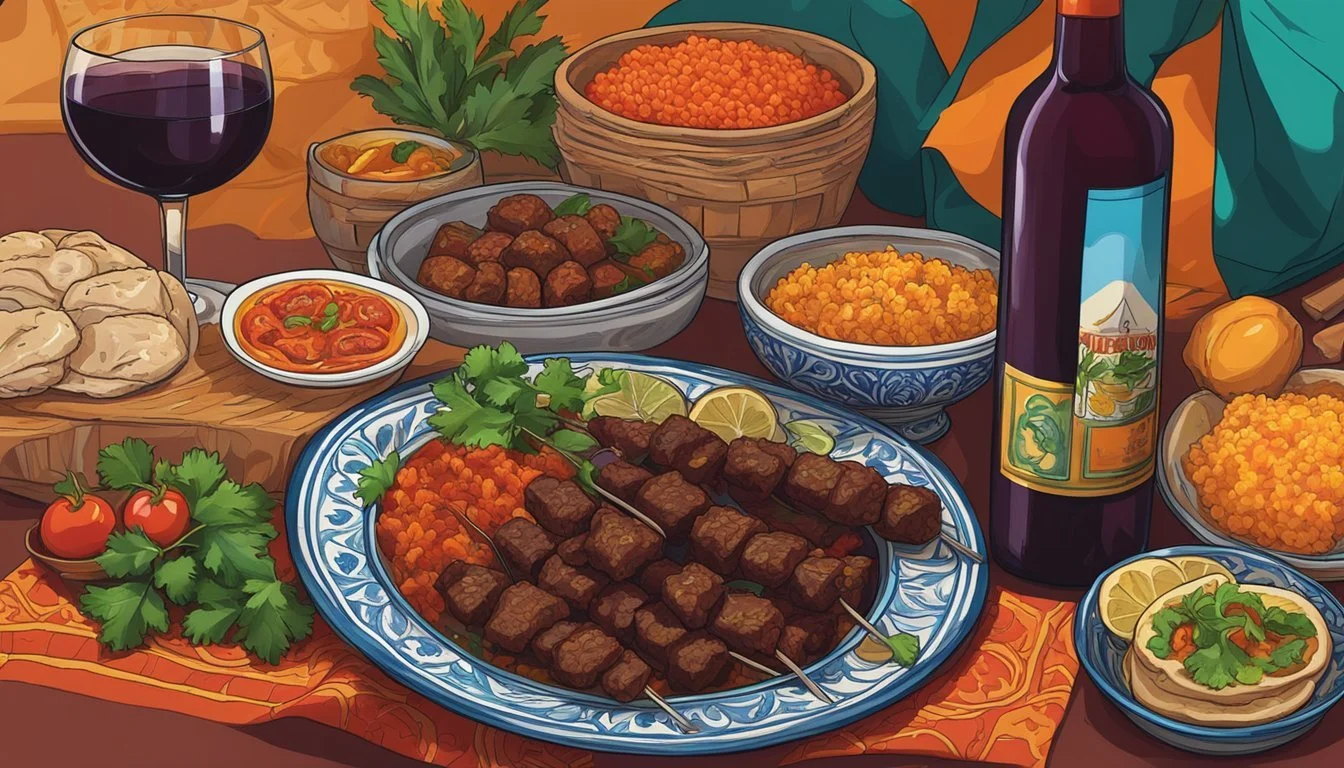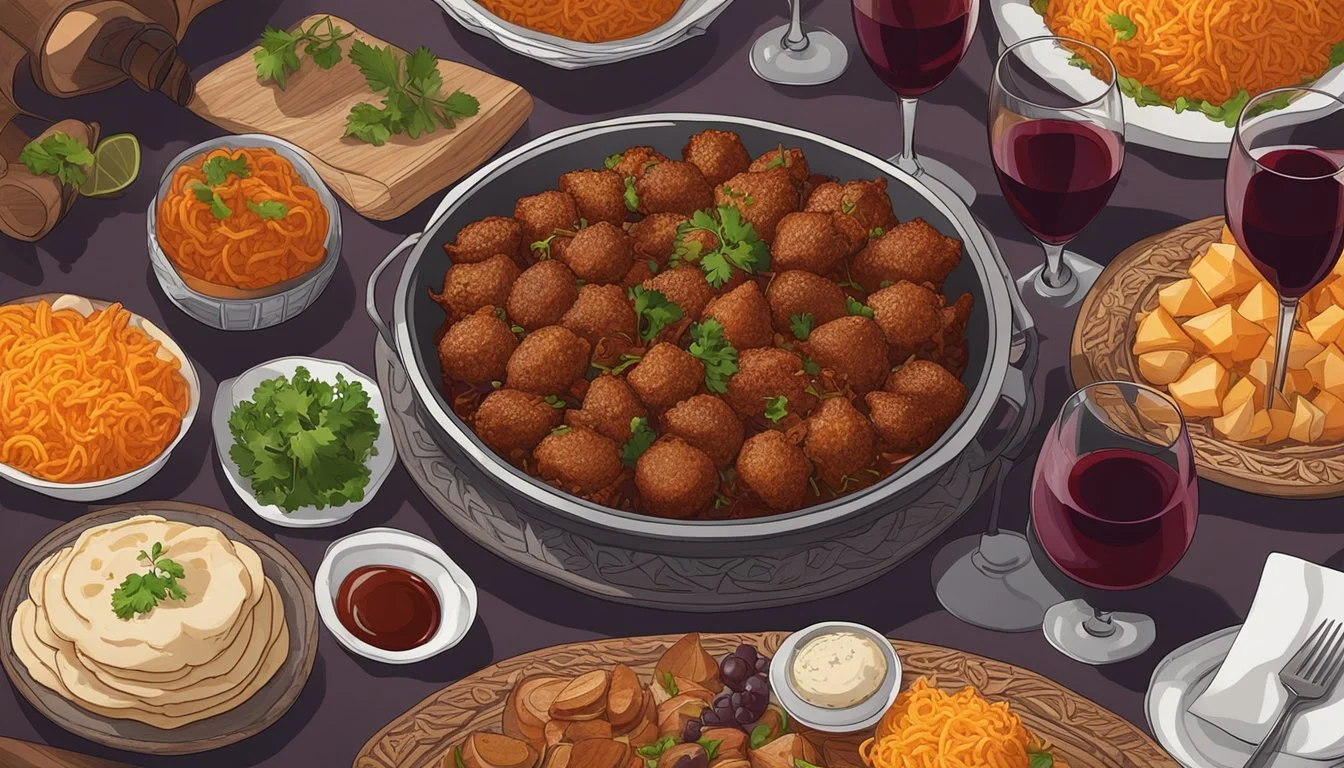What Wine Goes Well with Uzbek Food?
Pairing Tips for an Exotic Cuisine
Pairing wine with Uzbek cuisine offers a delightful exploration into one of Central Asia's most vibrant culinary traditions. Uzbekistan, with its rich history and location as the crossroads of the Silk Road, has developed a diverse food culture influenced by various nomadic and settled civilizations throughout the millennia. This cuisine is characterized by hearty meat dishes, rice pilafs, and an array of vegetables and spices which can be wonderfully complemented by the right wine.
When selecting wine to accompany Uzbek dishes, one should consider the balance of flavors and the weight of the food. For instance, the national dish of Uzbekistan, Palov, made with rice, meat, and a mix of onions (What wine goes well with onions?) and carrots, pairs well with medium-bodied red wines which can complement the dish's heartiness without overwhelming it. Similarly, the intense flavors of seasoned meats and stews like Dimlama, laden with tender beef or lamb and root vegetables, call for robust wines that can stand up to the rich fare without competing for dominance on the palate.
Understanding the spices and cooking methods commonly used in Uzbek cuisine is essential in the selection of wine. Aromatic spices such as cumin, coriander, and paprika, which are often used, go well with wines that have a hint of spice themselves, such as a Shiraz or a Zinfandel. Wines should be chosen with care to enhance both the food and the overall dining experience, reflecting the confident and communal spirit of Uzbek culinary tradition.
Culinary Staples of Uzbek Cuisine
Uzbek cuisine reflects the country's rich Silk Road history, offering an array of rich and hearty dishes that are typically built around meats, rice, vegetables, and spices. These staples have been perfected over centuries, playing a fundamental role in the daily diet and cultural practices.
Plov: The National Dish
Plov, often considered the national dish of Uzbekistan, is a flavorful rice pilaf. Key ingredients include:
Rice: The base of the dish
Meat: Usually beef or lamb, though other meats like chicken can be used
Carrots and Onions: For sweetness and depth
Garlic and Spices: For a punch of flavor
The hearty combination is a staple at gatherings and a symbol of hospitality.
Soup and Stew Variations
Uzbek soups and stews come in many variations, but a few stand out for their popularity and flavor profile.
Shurpa: A rich lamb soup with root vegetables and herbs, commonly featuring dill.
Dimlama: A one-pot stew with meat (commonly lamb or beef), potatoes, cabbage, and bell peppers.
Both dishes are revered for their comfort and depth of flavor, derived from long simmering times.
Bread and Pastries
Bread is an essential part of Uzbek meals, with varieties such as:
Samsa: A pastry filled with meat (often lamb), onions, and spices, usually baked in a tandoor oven.
Guzlama: A thin, flaky bread stuffed with greens or pumpkin.
These breads are not just food but an art form, often shared during tea time or as a part of main meals.
Meat and Kebabs
Meat is central to Uzbek cuisine and is most notably celebrated through:
Kebabs (Shashlik): Skewered and grilled cubes of meat, often marinated with spices and sometimes vegetables like onions and bell peppers.
Horse Meat: Although less common, horse meat is also a traditional meat in Uzbek cuisine.
These dishes showcase the Uzbek skill in grilling and the use of fresh meats, with lamb and beef being the most popular choices.
Wine Pairing Fundamentals
In pairing wine with Uzbek cuisine—a tapestry of flavors comprising cumin, dill, and various meats—the goal is to complement the dish's strength and boldness or to provide a refreshing counterpoint.
Understanding Flavor Profiles
Uzbek cuisine is marked by its aromatic spices and richly flavored dishes, such as plov, which melds rice with carrots, onions, and meat. The flavors tend to be hearty, often incorporating cumin and fresh dill. Meals with a base of sour cream or featuring tomatoes suggest a balance of creaminess or acidity. When pairing wine, the diner must consider how the taste of the wine will interact with these elements. For spicier dishes with bold flavors, wines with robust profiles are typically chosen. If the meal takes a more delicate route, such as a vegetarian soup, a wine that does not overpower the subtlety of the food is ideal.
Wine Selection Tips
Wine options for Uzbek dishes can be diverse, but there are guidelines to enhance the dining experience:
Boldness & Strength: For hearty meat dishes, choose full-bodied red wines that can match the intensity of flavors.
Delicacy: Lighter fare or vegetarian options benefit from white wines that offer a refreshing contrast without overwhelming the dish.
Acidity: Wines with good acidity can cut through the richness of dishes that are oil-rich or heavily spiced, refreshing the palate.
Taste Pairing: Wines with a hint of sweetness balance out the savory aspect of many Uzbek recipes that include onions and carrots.
In summary, the wine should respect the food's flavor profile, whether by matching its weight or providing a complementary contrast.
Recommended Wine Varieties
Selecting the perfect wine to pair with Uzbek cuisine involves considering the balance of flavors in dishes such as plov, kebabs, and salads. The following wine varieties are chosen to enhance the dining experience by complementing the heartiness and distinct spices typical in Uzbek food (What wine goes well with Uzbek food?).
White Wines for Uzbek Dishes
Riesling: An ideal match for Uzbek plov, a rice dish often cooked with meat (lamb or beef) and carrots. The crisp acidity and fruity sweetness of a German Riesling will complement the richness and subtle sweetness of the carrots.
German Riesling – Best served with hearty rice dishes.
Chardonnay – Pairs well with chicken and vegetarian offerings.
Chardonnay: When meals include lighter meats such as chicken or are more vegetarian-focused, a Californian Chardonnay's fuller body and buttery notes provide a harmonious counterpoint to the savory flavors.
Red Wines to Complement Uzbek Flavors
Malbec: For robust meat dishes like beef kebabs and stews with peppers and tomatoes, an Argentinian Malbec's bold flavors and soft tannins make it an excellent companion, accentuating the dish's heartiness without overwhelming its spices.
Argentinian Malbec – Complements beef and hearty stew effectively.
Shiraz: The spiciness and ripe fruit flavors of a Shiraz can stand up to flavorful lamb dishes and salads replete with potent herbs and spices, creating an integrated and satisfying culinary experience.
Shiraz – Suitable for spicy meat dishes and flavorful salads.
Regional Specialties and Wine Matches
In the bustling cities of Uzbekistan, traditional dishes paired with the right wine accentuate the flavors inherent to the region's cuisine. Here, the culinary experience is influenced by the Silk Road that once connected Asia to the world, and the food and wine duo pays homage to these cultural exchanges.
Tashkent's Delicacies
In Tashkent, the spirited capital of Uzbekistan, food often features hearty meats and fresh vegetables. Plov, a rich pilaf that is the nation's pride, pairs well with a full-bodied red wine. A Shiraz or Zinfandel, with its robust profile, complements the savory flavors of lamb and rice seasoned with cumin and other spices. Tashkent's version of dumplings, filled with minced meat and served with sour cream, invites a lighter red wine, such as Pinot Noir, which balances the dish's richness without overwhelming it.
Samarkand and Bukhara
Samarkand and Bukhara, two ancient Silk Road cities, offer a palette of flavors in their regional dishes. Shivit oshi, a dill-infused noodle dish, is a specialty of Khiva, another historic city, but also enjoyed in Samarkand and Bukhara. A dry, crisp white wine, like a Sauvignon Blanc, enhances the herbaceous notes of the noodles. For a classic salad of tomatoes, onions, and radishes often found in these cities, a light-bodied white wine such as Pinot Gris serves as a fresh, palate-cleansing counterpart.
Each dish in these regions tells a story of the land, and when paired with wine from either local or international vineyards, it invites diners on a cultural and sensory journey through the tastes of Uzbekistan.






